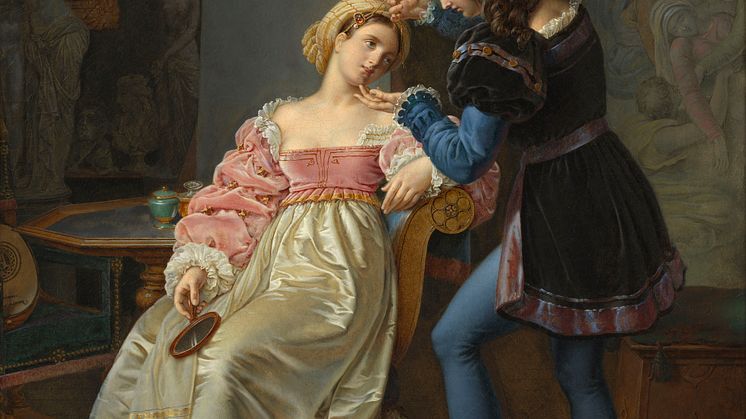
Press release -
New acquisition: Painting by the French painter Coupin de la Couperie
Nationalmuseum recently acquired a work by French painter Marie-Philippe Coupin de la Couperie. The painting is called Raphael Adjusts Fornarina’s Hair Before Painting her Portrait and was put on display at the Saloon in 1824. It is a fine example of what is known as the Troubadour style, which became popular in the years following the French Revolution.
The painting Raphael Adjusts Fornarina’s Hair Before Painting her Portrait by the painter Marie-Philippe Coupin de la Couperie (1773–1851) is one of the more prominent examples of the genre known as the Troubadour style. It was commissioned by Anne Marie Hortense Perrégaux, Duchess of Ragusa (1779–1857), and was exhibited at the Saloon of 1824. The motif with the famous Renaissance painter also shows that the Troubadour style encompasses anecdotal depictions of the Renaissance despite the Middle Ages having ended. The adored Renaissance painter is depicted as he arranges his model’s, la Fornarina, hair. She has been identified as Margherita Luti and is said to have been Raphael’s mistress as well as his model. Coupin de la Couperie has not only paraphrased the Renaissance painter’s famous depiction of La Fornarina in Palazzo Barberini, but also his way of identifying himself on some of the accessories. Instead of, like Raphael, choosing the band on her left arm, Coupin de la Couperie has placed a Latin inscription on the hem of la Fornarina’s dress saying that the painter composed the work in 1824 in honour of the divine Raphael.
Nor was the subject a new one. Ingres had produced a version as long before as 1814, but he was far more restrained as regards colour temperature than Coupin de la Couperie. The latter’s painting is a virtuoso example of fine art with a lustre almost as if it were enamelled, reminding us that the painter began his career as a ceramics artist at the porcelain manufactory in Sèvres. The depiction of Raphael with his favourite model and mistress hung at the Duchess of Ragusa’s palace Viry-Châtillon, where she had also had a neo-Gothic garden pavilion built with interior decoration and furnishings in the same style.
“We are very happy to have been able to acquire a high-class example of history painting from the French romantic period because most important paintings of this kind are already hanging at the Louvre in Paris or other major museum collections,” says Magnus Olausson, head of collections at Nationalmuseum.
During the first half of the nineteenth century, history painting flourished in European art and art handicraft. In France, the sense of loss of historical monuments, which had been more or less wiped out during the Revolution, had heightened this passion for historical subjects, but it was not the beginning of interest in the French Middle Ages. This had already been in existence, during l’ancien régime, but it gained new life and became even more intense as a result of vandalism during the revolution. The Troubadour style came to be the collective name for the phenomenon. A distinctive aspect of the style was its character of malleability and ambiguity. It came to be loved by both the First Empire, the Restoration and the July Monarchy, despite each in turn combatting the others. These different political regimes were just as keen to adopt the Troubadour style and make it their own distinguishing characteristic, the reason being that it was considered to symbolise all that was French and therefore imparted legitimacy. Chivalrous virtues, praised by troubadours in their ballads, gave the style its name. Empress Joséphine (1763–1814) is usually described as an important promoter of the Troubadour style. In her art gallery at the Château de Malmaison, the empress had several works exemplifying the Romanticism genre, a penchant she shared with one of her intimate confidantes, Anne Marie Hortense Perrégaux, Duchess of Ragusa. The duchess continued to acquire paintings of this kind even after Empress Joséphine’s death.
Nationalmuseum receives no state funding with which to acquire design, applied art and artworks; its collections are enriched through donations and gifts from private foundations and funds. The acquisition was made possible by grants from the Hedda & N.D. Qvist foundation.
Inventory number:
Marie-Philippe Coupin de la Couperie, Raphael Adjusts Fornarina’s Hair Before Painting her Portrait, 1824, NM 7498.
For more information
press@nationalmuseum.se, +46 (0)8-5195 4400
Categories
Nationalmuseum is Sweden’s museum of art and design. The collections comprise older paintings, sculpture, drawings and graphic art, and applied art and design up to the present day. The museum building has currently been renovated and reopened in autumn 2018. Nationalmuseum has partnerships with Svenska Dagbladet, Bank of America Merrill Lynch, The Wineagency and the Grand Hôtel Stockholm.

